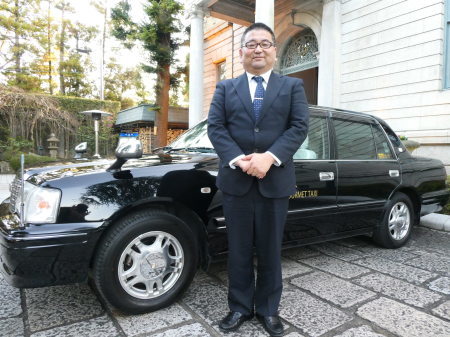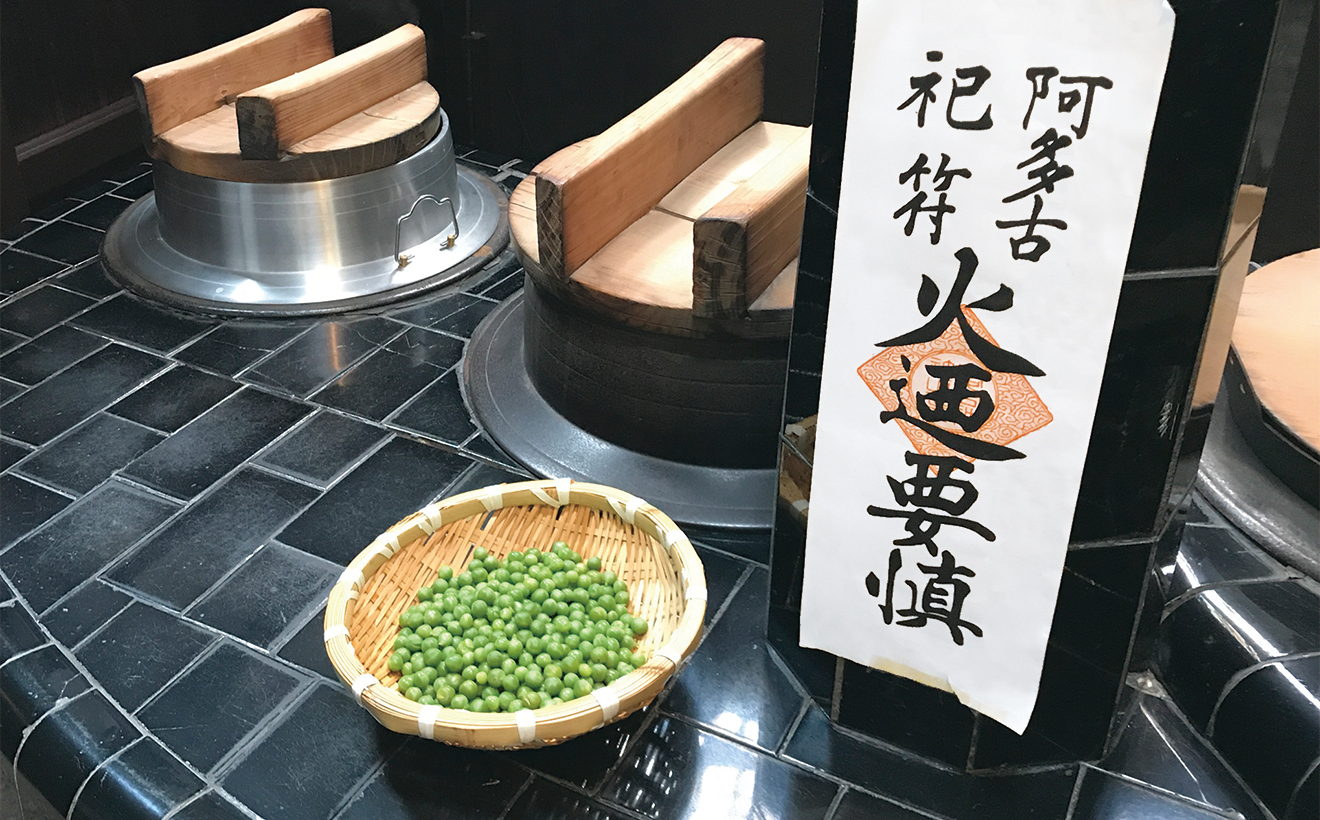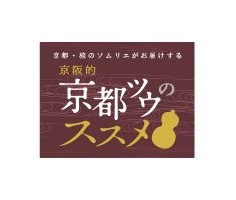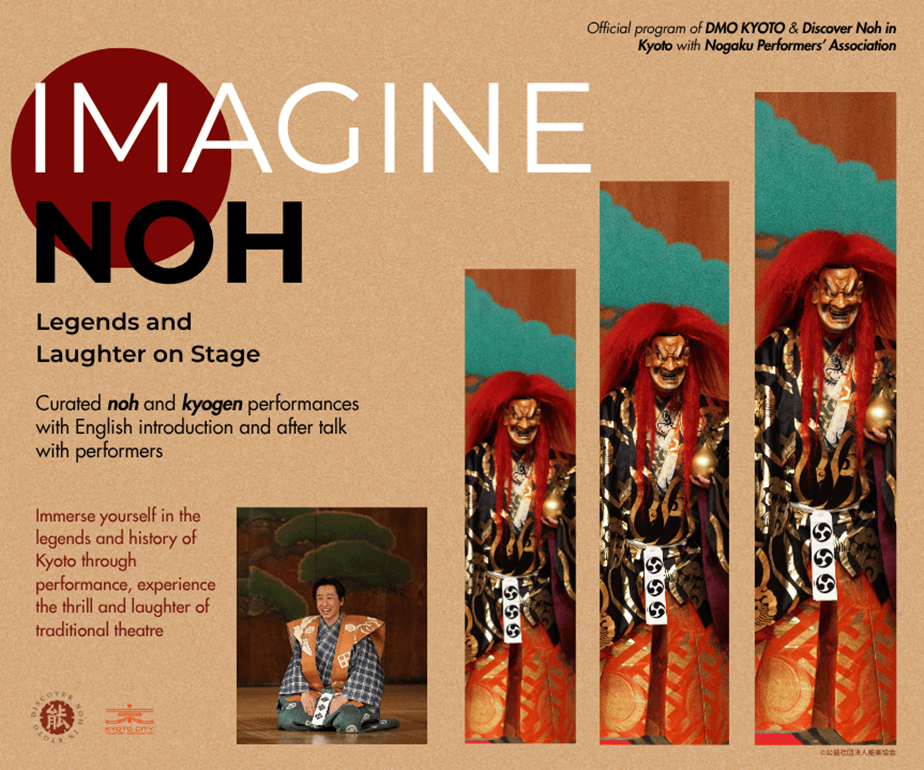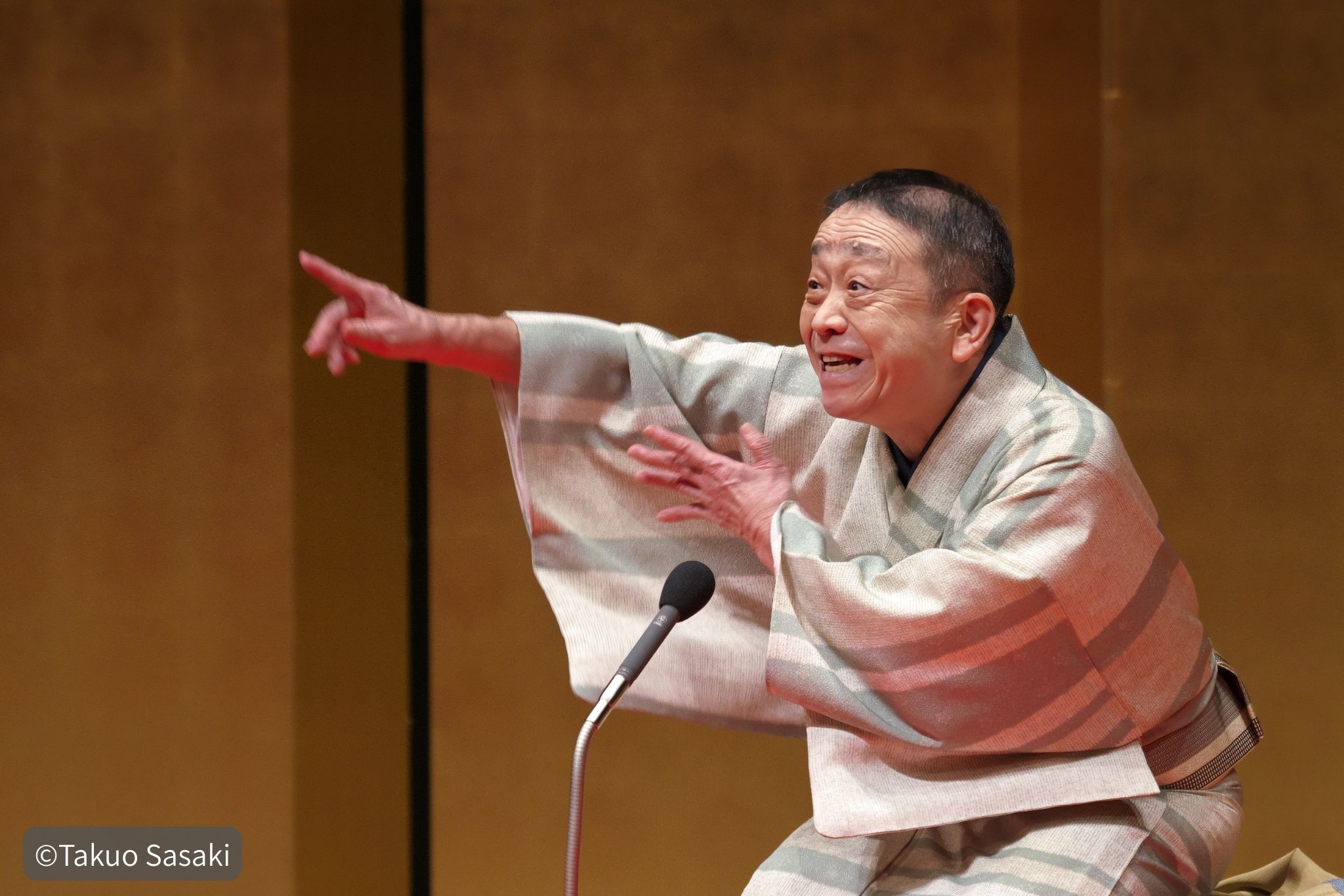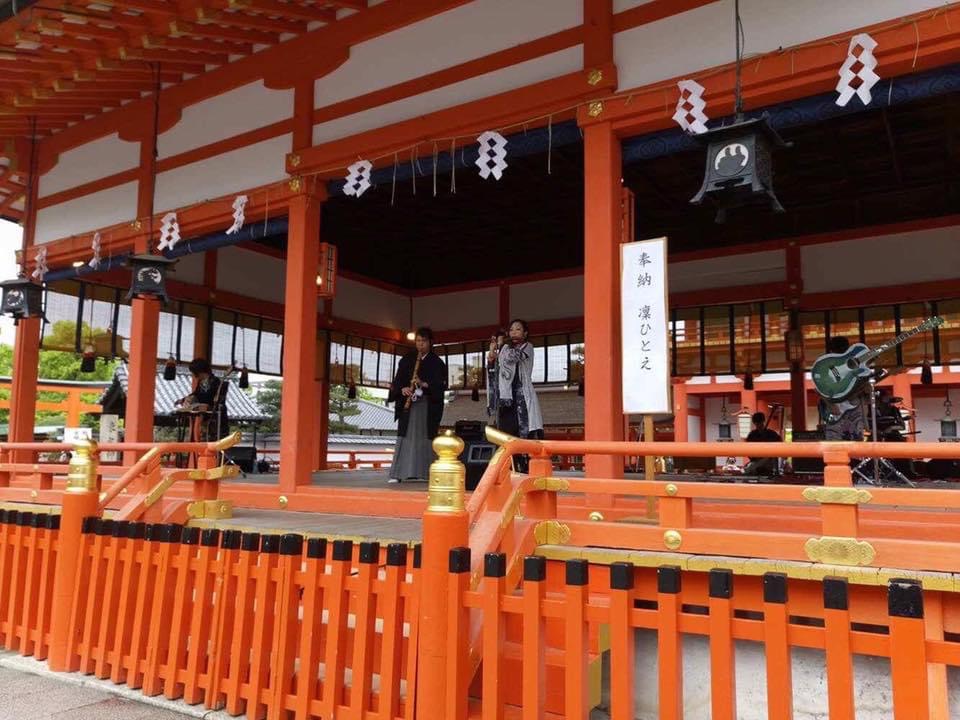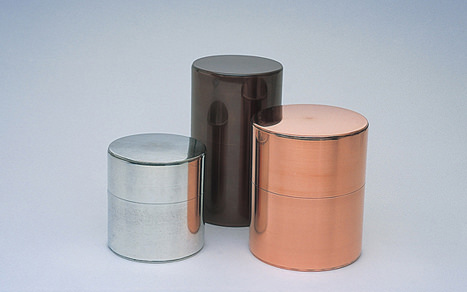
Traditional Industries of Kyoto refers to industries planned and produced primarily within the district of Kyoto City which make products that are closely connected to traditional Japanese culture and lifestyles through the use of traditional techniques and methods.
Gaku-kanban (Wooden signs)

These signs are made in a process that involves cutting lumber to shape to make the base shape of the sign, then attaching a brush-drawn draft to the wood, and carving out the characters of the draft. After putting an undercoat on the carved out characters, they are painted with paint or lacquer and then pressed with gold leaf. Old calligraphy is used for the characters that are carved into the sign, and it is an important point that the characters be carved shallowly and roundly.
Molds for sweets
Molds are required to make oshigashi molded sweets. Most of the molds used across Japan today were made in Kyoto. Cherry wood that has been dried for at least 3 years is used to make the molds, and they are made in a process of drying the wood, making the base, rough carving, preparation of the middle and fine carving. Tools used include knives and whetstones, and each craftsman works to their best ability to make unique molds.
Wigs
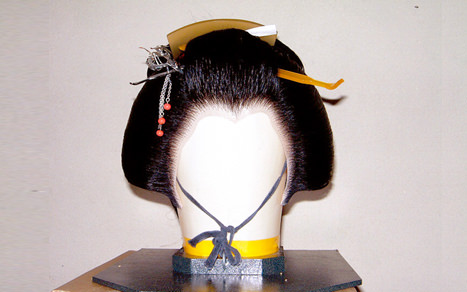
A wig is made by pounding a piece of metal into shape to match the shape of the head of the actor who will wear it. Since everyone’s head is shaped differently, there must be as many models as there are people. More often than not, human hair is used for the hair of the wig. The overall feel of a wig can change easily by the arrangement of a hair or two along the hairline, so this is the most nerve-wracking part to make. Wigs are broadly divided into the two categories of film use and stage use.
Wire netting crafts
The only tool needed to make traditional wire netting crafts is a base with nails attached. The wire is knitted around the nails. The wire can be twisted many times in order to make whatever kind of weave the craftsmen wishes to make, and the fact that it can be redone as required is an advantage of the method. Besides their time-tested use in the kitchen, in recent years these crafts are being used as containers for food and for other miscellaneous purposes.
Karakami (Paper for sliding doors)
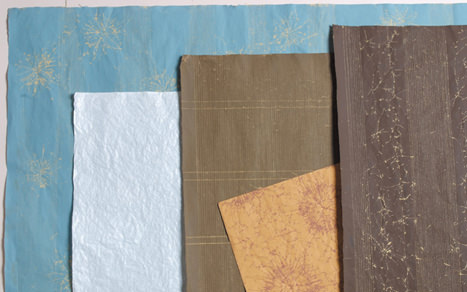
Karakami used to refer to craft paper that came from the Tang dynasty of China, but later the paper used for sliding doors came to be called by the same name. The paper used is handmade Echizen-washi or Kurotani-washi paper. No baren (hand tool used in woodblock printing) is used, so the grooves in the woodblock are cut deeply. The paper is pressed with the palms of the hands, giving it a soft feel. Karakami made using old woodblocks is required in Kyoto for temples and imperial villas, and the production process and printing process both use traditional techniques that have been passed down over the generation.
Karuta (Cards)
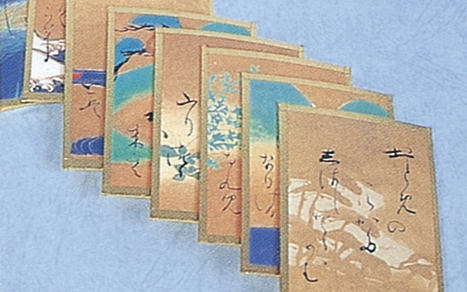
It is said that it was in the Edo period that many types of cards including Hyakunin’isshu (the game of 100 famous poems) cards and flower cards came to be made. Since that time and even still today, they have mostly been made in Kyoto and shipped around Japan. The part of card-making that requires the most skill is the backing step in which glue is applied to each piece and the edge of the back piece is bent over the front in to create a border.
Kiseru (Pipe)
After World War II, kiseru pipes came to be prized more as tea ceremony implements and antiques than as actual smoking pipes. The former is the type favored by the head school of the tea ceremony, and the latter is sometimes decorated with relief and zogan inlay techniques.
Kyo-kawara (Roofing tiles)
Kyoto has prospered as one of the main production centers for roofing tiles since it became capital of Japan. After World War II, there has been an emphasis on special handcrafted tiles. There are over 700 types of Kyoto tiles, and they focus on not the basic type that covers most of a roof but rather on special tiles like demon tiles, eaves, verge tiles and other tiles with specific purposes. They are sturdy and their surface resembles oxidized silver, and these features which result from their being made painstakingly by hand are characteristic of Kyoto tiles.
Kyo-sanadahimo (Wrapping string)
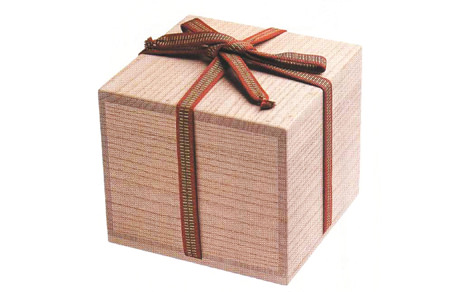
Kyoto wrapping string is a beautiful string that is wrapped around Kyo-sashimono woodcrafts and kiribako paulownia wood boxes. The weave patterns are beautiful and have an elegant taste. These strings are said to have once been used on sword scabbards and hilts. These days, the number of craftsmen that can still make them has decreased, and now craftsmen capable of making the luxurious string by hand can be found only in Kyoto.
Kyo-tabi (Socks)
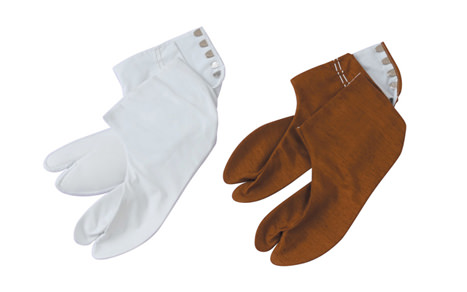
There are only a few shops left in Kyoto that sell traditional Japanese socks, compared to 35 shops before World War II, but there is still a strong demand for their superior quality. A highly absorptive cotton is used for the material. The material has very little stretch, so making socks that fit feet just right requires expert technique.
Kyo-tsugegushi (Boxwood comb)
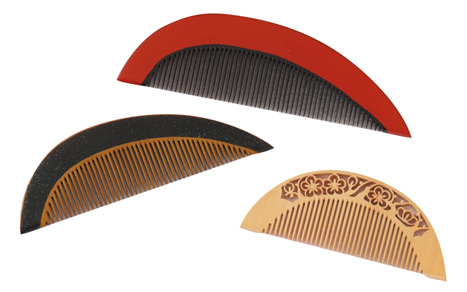
Boxwood combs are made carefully over a long period of time, pass over hair smoothly without causing static electricity, and are said to make hair beautiful. After a tree is selected, the wood is fumigated, dried, pressed into shape, the teeth are sawn and then it is cast. The sawing of the teeth in particular is notable in that each gap must be sawn, the teeth must be sanded smooth with a scouring rush plant, then polished with the leaves of a muku tree and finally polished to a high gloss with an uzukuri tool, and the careful completion of this process results in a high-quality comb.
Kyo-tsuzura (Woven basket)
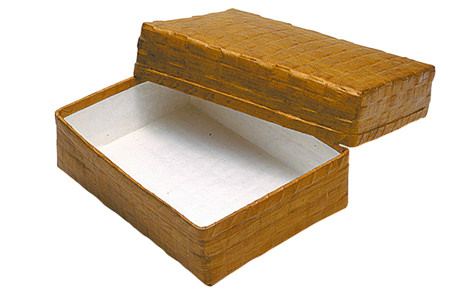
Tsuzura baskets are made in a 15-step process which includes splitting and peeling the bamboo, weaving a basket, applying thatch to the corners, covering the basket with washi paper, and then finishing the basket with lacquer. They are largely used to store wedding garments and as dual-purpose baskets for kimono and tea ceremony equipment, but they are also used as bathroom baskets as well as for storage of letters and small items. These days they are also used for the akeni boxes in which sumo wrestlers put their mawashi loincloth and other items.
Kyo-maru’uchiwa (Round fan)

These name-inscribed fans are given by maiko and geiko (apprentice geisha and geisha) to favored patrons, and the handle and ribs of the fan are made from a single piece of bamboo. The paper is washi, and each fan is made by hand. It is also notable how patterns are burned on the handle with sulfuric acid.
Kyo-yumi (Bow)
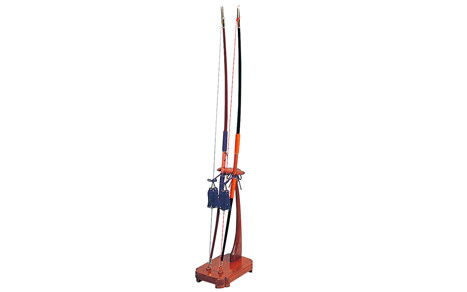
Springy bamboo taken from the Yamashiro area of Kyoto is used as the main material. There are 6 processes in making a bow: cutting the bamboo, treating it, making the inner layer of wood that will be sandwiched between 2 pieces of bamboo, carving the bamboo, putting the pieces together and then making the finishing touches. Treating the bamboo takes a particularly long time, and for a high quality bow it can take as long as 30 years. Some bows are also given a coat of lacquer.
Kyo-wagasa (Umbrella)
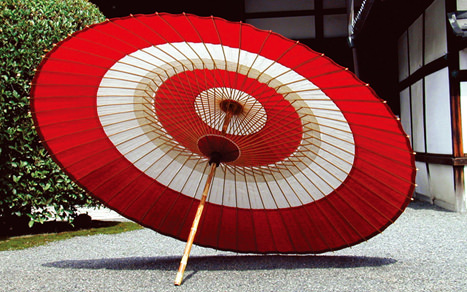
In the past, types of umbrellas like bangasa and tomogasa were produced, but presently they are few in number. In their place, umbrellas like shuogasa / sashikake umbrellas are used in Shinto ceremonies as well as Buddhist ceremonies, tea ceremony, and store decoration. Kyoto umbrellas are made in a comprehensive process of connecting the ribs to the sliding piece, attaching the paper to the ribs, wrapping the head of the umbrella, oiling the paper and applying lacquer.
Kirikane (Decorative gold leaf)
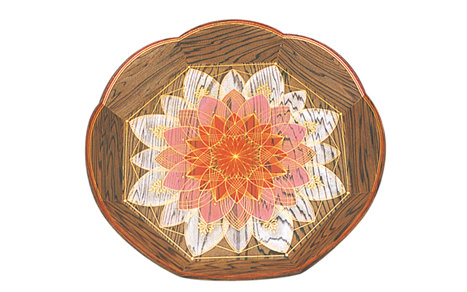
Kirikane starts with putting together pieces of gold leaf to give them thickness and body. The gold leaf is then cut and applied to things like Buddhist statues and scrolls. There are no drawings underneath to guide the work; the gold leaf is applied directly in one go. Experience and gut feelings are the key to doing it right. Most of the demand for kirikane is from the Buddhist world, but new uses such as for decoration of wooden boxes are being developed.
Saga-men (Mask)
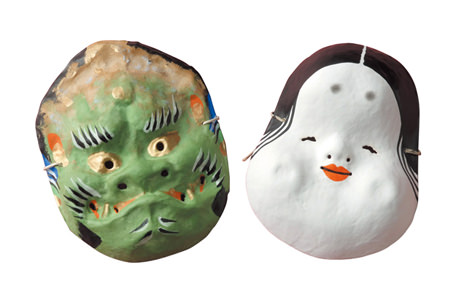
These masks were given out by shrines and temples in Saga as charms or amulets to ward off ill fortune. They disappeared for a while with the changing of the times, but they have recently had a revival. Washi paper is shaped against a plaster model, and then after a coat of primer, the mask is colored with many layers of paint.
Shakuhachi (Bamboo flute)

Shakuhachi flutes are made of bamboo and painted with lacquer. Selection of the bamboo is the most important stage of shakuhachi production, to the degree that the final price of the flute can be said to be determined when the bamboo is first dug out of the ground. The bamboo is then prepared by leaving it for about 4 years. The inner diameter of the flute is carved to produce a custom sound that matches what is popular at the time.
Shamisen (3-stringed Japanese banjo)
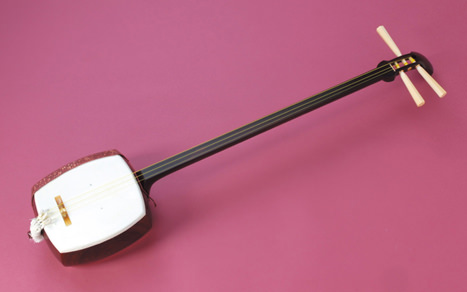
Indian red sanders wood is used as the main material. Shamisen are made to match the hand size and ability of the player. They produce a better sound the more years have passed since their making. Out of the processes of cutting the wood, sanding, polishing, lacquering, attaching the leather and stringing the instrument, attaching the leather is particularly difficult and important. It must be stretched to the limit.
Shirabeo (Linen tuning ropes)

Shirabeo are linen ropes used to tune kozutsumi, ozutsumi and taiko drums that are used in Noh, Kabuki, nagauta and minyo traditional music. They are made of Japanese linen, and they go through 25 processes before completion. They are luxury handmade items that have been in use from the Momoyama period to the present.
Chazutsu (Tea container)
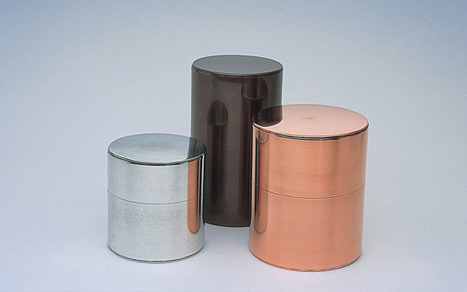
Most chazutsu are machine-made these days, but a completely handmade one takes over 130 processes to produce. The precision fit that allows the cover to close by itself when placed on the container is unique to handmade chazutsu. Some of them are unpainted so that you can enjoy the beauty of the copper or tin materials from which they are made, which is only enhanced by natural changes in coloration that occur over time.
Chochin (Lantern)
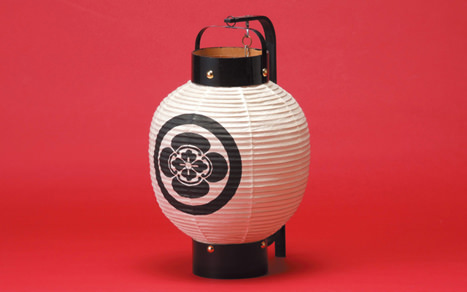
Lantern-making is divided into 2 methods, ippongake-shiki or jibari-shiki in which the ribs of the lantern are attached one at a time, and makibone-shiki in which the ribs are wrapped around in a spiral fashion. Round and flat ribs are used in both types. In Kyoto, there has long been division of labor in the processes of making the sides that are attached to the top and bottom parts of the lantern, making the body of the lantern, and applying the finishing touches. High-quality lanterns are produced this way in Kyoto to this day.
Nenjutama (Prayer beads)

Beads fall in the rough categories of glass, nut, fragrant wood, and precious stones, but linden tree wood, sandalwood and Japanese aloeswood beads comprise the majority of beads produced. They are cut from a single plank and polished until a natural luster is drawn out of the wood. The basic number of beads in a set of prayer beads of 108, but sets can vary from 14 beads to 1080, and each individual bead has a meaning.
Noh-men (Noh mask)

There are about 80 types of masks used in Noh plays. They are carved out of cypress wood using a variety of chisels, after which they are painted with whitewash and glue. Next the entire surface is carefully sanded. The eyes, eyebrows and hair are drawn with ink, and the lips are painted with red ink and vermillion pigment, adding expression. Noh mask making is a traditional craft that brings together sculpture and painting and requires special techniques for lacquering the back of the mask, metal working for the eyes and teeth, and for attaching hair.
Hanakanzashi (Flower hairpin)

Not many people tie up their hair these days, so most of the demand for flower hairpins comes in the form of special orders for maiko apprentice geisha. Habutae silk, washi paper, hiraito raw silk and wire are used as materials, and the hairpins are made entirely by hand. Habutae silk is sent out to be dyed while washi paper and hiraito raw silk are dyed in-shop. The dyed habutae is then punched into shapes like flower petals with various chisels, finishing the hairpin beautifully in accordance with traditional rules.
Sailcloth bags
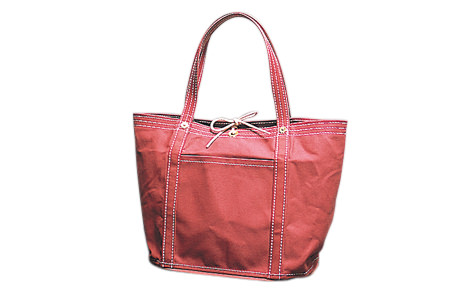
Sailcloth refers to thick cloth that weighs over 8 ounces (approximately 227g) per square meter. Sailcloth bags spread in the Meiji period as a result of their high level of practicality and fashionable design. Each piece of cotton or linen sailcloth is cut with scissors and sewn by craftsmen using sewing machines, and the work of these processes and attaching the metal parts is all done by hand.
Fushimi-ningyo (Fushimi dolls)
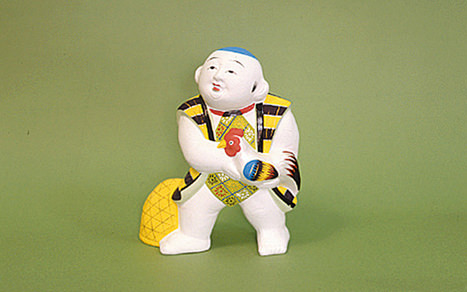
It is said that of the over 90 types of clay dolls in Japan, there are none the lineage of which cannot be traced back to Fushimi dolls. They are known for their folksy beauty. They are made through the processes of creating a mold from an original model, preparing the clay, detailing, firing the clay and coloring the doll. This labor was divided between multiple people in the past, but these days, all of the processes are performed by a single craftsman.
Strings for Japanese string instruments
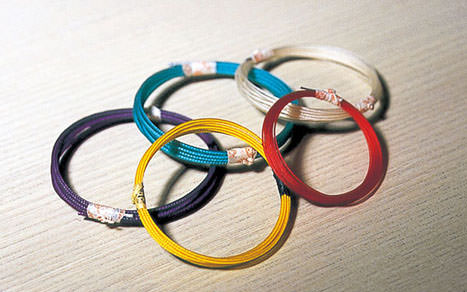
The strings for Japanese instruments like the shamisen, biwa, and instruments used in gagaku are made mostly from raw silk even today. Raw silk taken from northern Shiga Prefecture is considered to be the best silk for this purpose. It is made into instrument strings through a process of repeated twisting and stretching, but each string must be able to hold a tone fitting its role, and it takes skill and experience for a craftsman to achieve this.
Arrows
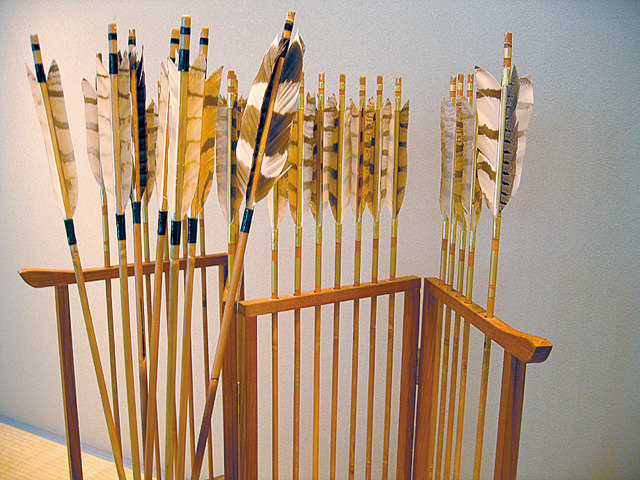
Bamboo arrows are notable for the way they can be custom made so that their thickness, weight, length, flexibility and balance meet the needs and preferences of the archer. Besides general-use arrows, there are special arrows used in ceremonies, and there are over 10 types of arrows with specific roles that include different types of whistling arrows and arrows with blunt wooden heads, among others.
Engagement decorations and mizuhiki (paper cord crafts)
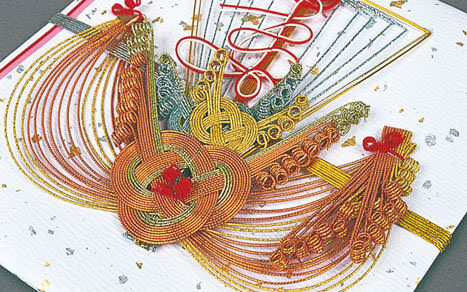
Engagement decorations and mizuhiki crafts are among the many ceremonies and customs that have been transmitted to modern times through the Kyoto imperial palace. Crafts include the auspicious charms of shochikubai (pine, bamboo and plum) and the crane and turtle as well as other related decorations and decorations for food and sweets, and they are all required for engagement ceremonies. These days, they are sometimes also used for interior decoration. There are over 100 types of mizuhiki, and they are handmade through processes that include tying, bending, interlacing and weaving.
Wa-rosoku (Japanese candle)

Japanese candles lost popularity at one time due to the spread of western candles, but in recent years they have seen new demand for use in lighting Buddhist ceremonies and evening tea ceremonies. In their production, the pith of the common rush is wrapped around a cylinder of washi paper and wax taken from the Japanese wax tree is painted onto the cylinder. This unique production method makes for an entirely plant-based candle with a peaceful and beautiful flame that produces little smoke.
Kyo-koma (Top)
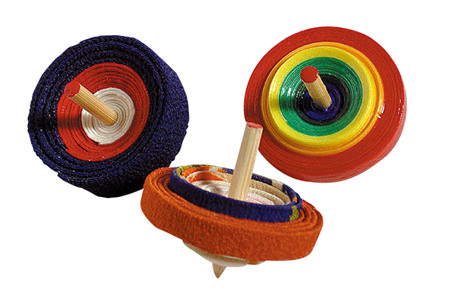
These tops originated as playthings for upper class ladies of the Azuchi-Momoyama period. They are made with wrappings of kimono cloth and cotton string, and they are distinguished by the beauty of their texture and coloration. They spin easily with a light touch of the fingertips whether placed on a tatami mat or a table, and they are made to be enjoyed indoors. The shape is formed and set in a process of making a central pole, making hirahimo string, and then wrapping the body. Sometimes ornamentation such as gold thread or pictures are then applied.
Incense

An unlimited variety of aromas can be created by mixing valuable Chinese spices. Religious incense, tea ceremony incense, personal incense… the various incense products enjoyed in the present day come from Kyoto culture that traces back to the Heian period. The thin, flexible and aromatic incenses of Kyoto, made with luxury ingredients, are collectively known as Kyo-senko.

